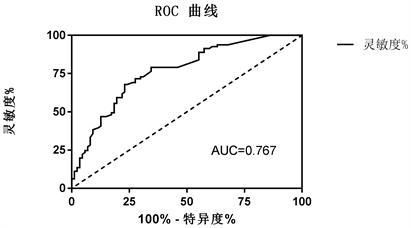Advances in Clinical Medicine
Vol.
11
No.
05
(
2021
), Article ID:
42687
,
9
pages
10.12677/ACM.2021.115337
高同型半胱氨酸血症患者颈动脉内膜中层厚度与冠心病的相关性及血运重建预测价值
于航1,于方2,刘松3,蔡尚郎3,阮士苗1,张文忠3*
1青岛大学,山东 青岛
2济宁市第一人民医院,山东 济宁
3青岛大学附属医院心内科,山东 青岛

收稿日期:2021年4月25日;录用日期:2021年5月8日;发布日期:2021年5月27日

摘要
目的:探讨高同型半胱氨酸血症患者动脉内膜中层厚度与冠状动脉粥样硬化严重程度的相关性,并分析血运重建临床预测价值。方法:本研究纳入167例高同型半胱氨酸血症患者,行颈部血管超声、冠状动脉造影检查(Coronary angiography, CAG)以及相关检验,计算Gensini积分和Leaman积分。根据CAG结果分为血运重建组81例,药物保守治疗组86例,应用受试者工作特征曲线(receiver operating curve, ROC)对血运重建组患者进行分析。结果:Crouse积分与Gensini积分和Leaman积分之间均呈现正相关表现,其相关系数分别是0.5303,0.57。CIMT的预测冠脉血运重建的概率AUC = 0.767。结论:高同型半胱氨酸血症患者颈动脉斑块与冠心病存在相关性,颈动脉斑块的有无对冠脉血运重建具有预测价值。
关键词
高同型半胱氨酸血症,冠心病,颈动脉内膜中层厚度

Correlation between Carotid Intima-Media Thickness and Coronary Heart Disease in Patients with Hyperhomocysteinemia and Predictive Value of Revascularization
Hang Yu1, Fang Yu2, Song Liu3, Shanglang Cai3, Wenzhong Zhang3*
1Qingdao University, Qingdao Shandong
2Jining No. 1 People’s Hospital, Jining Shandong
3Department of Cardiology, The Affiliate Hospital of Qingdao University, Qingdao Shandong

Received: Apr. 25th, 2021; accepted: May 8th, 2021; published: May 27th, 2021

ABSTRACT
Objective: Investigate the relationship between the thickness of the arterial intima-media and the severity of coronary atherosclerosis in patients with hyperhomocysteinemia, and analyze the clinical predictive value of revascularization. Methods: This study included 167 patients with hyperhomocysteinemia who underwent cervical vascular ultrasound, coronary angiography (CAG) and related tests, and calculated Gensini points and Leaman points. According to CAG results, they were divided into 81 cases in the revascularization group and 86 cases in the drug conservative group, and receiver operating curve (ROC) was used to analyze patients in revascularization group. Results: There was a positive correlation between Crouse points, Gensini points and Leaman points, and the correlation coefficients were 0.5303, 0.57, respectively. CIMT predicted the probability of coronary revascularization AUC = 0.767. Conclusion: There is a correlation between carotid plaque and coronary heart disease in patients with hyperhomocysteinemia. The presence or absence of carotid plaque has predictive value for coronary revascularization.
Keywords:Hyperhomocysteinemia, Coronary Heart Disease, Carotid Intima-Media Thickness

Copyright © 2021 by author(s) and Hans Publishers Inc.
This work is licensed under the Creative Commons Attribution International License (CC BY 4.0).
http://creativecommons.org/licenses/by/4.0/


1. 引言
高同型半胱氨酸血症属于临床常见疾病,是动脉硬化产生的主要因素,也是心血管疾病发生的风险因子之一。诸多研究表明,颈动脉粥样硬化与冠心病相关。国际指南建议对于怀疑低风险稳定型心绞痛的患者应接受心电图和(或)心脏彩色多普勒超声检查等非侵入性检查,以评估风险,早期识别不良事件,不建议首先选用CAG。大量的证据提示,不适当的血运重建治疗不仅会导致高昂的医疗费用,甚至会导致病情恶化,无法改善患者的预后通过B超检测颈动脉粥样硬化程度,有望预测冠心病的严重程度。在本研究通过对行CAG的高同型半胱氨酸血症患者同时进行颈部血管超声检查,旨在评价动脉内膜中层厚度(carotid intima-media thickness, cIMT)与冠心病的相关性,及对冠脉血运重建的预测价值。
2. 资料和方法
2.1. 入选标准
回顾性选取自2019年02月至2019年12月在青岛大学附属医院行冠状动脉造影检查且7天内于超声室行颈动脉超声的高同型半胱氨酸血症患者(同型半胱氨酸 ≥ 15.9 μmol/L)。本研究已获得患者或家属同意。
2.2. 排除标准
1) 感染性疾病、外伤、恶性肿瘤、继发性高血压、瓣膜性心脏病、主动脉夹层及急性心肌梗死1周内;2) 患者合并其他复杂内科情况。
2.3. 数据纪录
登记所有入选患者的性别、年龄、体质指数(BMI),记录吸烟与否、是否患有糖尿病和(或)高血压病,收集手术前3天内总胆固醇(total cholesterol, TC)、低密度脂蛋白(low-density lipoprotein cholesterol, LDL-C)、高密度脂蛋白(high-density lipoprotein cholesterol, HDL-C)、甘油三酯(triglyceride fatty acid, TG)等指标的检测结果。记录颈动脉超声Crouse积分 [1]。根据冠脉造影结果,计算Gensini积分 [2] 和Leaman积分 [3] 来评估冠状动脉狭窄的程度和严重性。由经验医师根据2018年血运重建指南分为血运重建组,药物保守治疗组。该研究符合伦理学,并得到青岛大学附属医院伦理委员会批准。
2.4. 统计学方法
采用软件SPSS21.0进行统计分析。计量资料采用均数 ± 标准差表示,计数资料用率(%)表示,计量资料比较采用x2分析,组间比较根据资料类型分别采用单因素方差分析(各组间比较采用LSD-t)并进行ROC分析并绘制ROC曲线。
3. 结果
3.1. 基线资料分析
组间性别比例,吸烟、酗酒、高血压患者所占比例,体质指数,高密度脂蛋白均无统计学差异(P > 0.05)。而低密度脂蛋白、总胆固醇存在组间统计学差异(P < 0.05) (如表1)。
Table 1. Comparison of baseline data between revascularization group and drug conservative group
表1. 血运重建组与药物保守组基线资料比较
*P < 0.05.
3.2. Crouse积分与冠心病的相关性
分别以Gensini积分、Leaman积分为纵坐标(y)行相关性分析,结果如表2所示,Crouse积分与Gensini积分、Leaman积分具有显著相关性(如图1、图2)。
Table 2. Correlation between Gensini score, Leaman score and Crouse score
表2. Crouse积分与Gensini积分与Leaman积分的相关性

Figure 1. Correlation analysis of Gensini score and Crouse score
图1. Crouse积分与Gensini积分的相关性分析散点图

Figure 2. Correlation analysis of Leaman score and Crouse score
图2. Crouse积分与Leaman积分的相关性分析散点图
3.3. CIMT对冠脉血运重建的预测价值
以冠心病患者是否需要血运重建进行ROC分析,CIMT的预测概率AUC = 0.767,CIMT对冠脉血运重建具有预测价值(图3)。

Figure 3. Predictive value of Crouse score in coronary revascularization
图3. Crouse积分对冠脉血运重建的预测价值
4. 讨论
在以往研究中,CIMT与冠心病存在相关性 [4] [5]。美国心脏协会基金会/美国心脏协会(ACCF/AHA)指南主张使用CMT来评估无症状人群的心血管风险 [6] [7]。在预测冠心病的严重性方面,Crouse评分可以作为一项独立的参考因素 [8] [9]。CIMT与AMI的发生风险明显相关,CIMT增厚0.01 cm,增加了大于10%的发生AMI的风险 [10]。Mu Y等人通过调查我国确诊为冠心病的207例患者,发现Crouse积分与Gensini积分(r = 0.455, P < 0.01)和Leaman积分(r = 0.358, P < 0.01)均呈正相关 [11]。
本研究用两种评分机制得出的冠状动脉钙化积分(Leaman评分、Gensini积分)分别与颈动脉Crouse积分相比较,均存在相关性。Gensini积分对冠脉节段做了比Leaman评分更详细的分层,根据不同节段血流量大小和传统血管名称分类,并根据血流量大小,得到不同的权重系数,将病变血管的数量、位置和狭窄程度等纳入考虑范围。Leaman评分依据冠脉供血的优势类型进一部划分了血管,考虑了冠状动脉病变程度和冠状动脉供血的优势类型,更好地反映了心脏血流动力学和左心室功能,但缺点是仅对于狭窄程度超过70%的冠状动脉血管纳入考虑范围,在评价早期血管病变略显不足,风险分层相对不确切。但是对于临床应用而言,当狭窄程度在大于70%时,往往提示针对病变血管需要进行进一步处理,如冠状动脉球囊扩张、支架植入术等操作,若存在多支血管狭窄大于70%,可能需要行心脏搭桥手术,Leaman评分对于预测患者血运重建价值更高。
本实验研究高同型半胱氨酸血症患者CIMT与冠心病的相关性,与以往结果相似,我们发现Crouse积分与Gensini积分和Leaman积分之间均呈现正相关表现,其相关系数分别是0.5303,0.57。Laclaustra等 [12] 在1423例中年男性研究中利用ROC分析,得出颈动脉斑块与冠状动脉钙化的相关性的AUC = 0.589,相比于股动脉与冠脉钙化相关性AUC = 0.719,表明股动脉粥样硬化与冠心病相关性更密切。以冠心病患者是否需要血运重建进行ROC分析,AUC = 0.767,CIMT对冠脉血运重建具有预测价值。临床上值得推广常规行颈部血管超声和下肢血管超声进行冠心病的早期筛查,指导临床工作。当患者检测颈动脉、下肢动脉超声发现血管硬化明显、易损斑块、斑块数量较多、较大厚度等情况时,若同时存在可疑冠心病临床症状时,应及时向患者说明、解释其危险性,采取有效措施,及时行冠脉造影以准确的了解患者冠状动脉血管情况,以免贻误病情、增加医患双方矛盾。颈动脉以及下肢均无斑块且临床症状相对较轻时,可不急于行冠脉造影手术,结合患者情况,可能更倾向选择冠脉CTA。在密切随访、观察的同时,择机选择合适的检诊手段,避免增加患者负担及有创检查的滥用、误诊等情况发生。
文章引用
于 航,于 方,刘 松,蔡尚郎,阮士苗,张文忠. 高同型半胱氨酸血症患者颈动脉内膜中层厚度与冠心病的相关性及血运重建预测价值
Correlation between Carotid Intima-Media Thickness and Coronary Heart Disease in Patients with Hyperhomocysteinemia and Predictive Value of Revascularization[J]. 临床医学进展, 2021, 11(05): 2341-2349. https://doi.org/10.12677/ACM.2021.115337
参考文献
- 1. Crouse, J.R., Harpold, G.H., Kahl, F.R., et al. (1986) Evaluation of a Scoring System for Extracranial Carotid Atherosclerosis Extent with B-Mode Ultrasound. Stroke, 17, 270-275. https://doi.org/10.1161/01.STR.17.2.270
- 2. Gensini, G.G. (1983) A More Meaningful Scoring System for Determining the Severity of Coronary Heart Disease. The American Journal of Cardiology, 51, 606. https://doi.org/10.1016/S0002-9149(83)80105-2
- 3. Leaman, D.M., Brower, R.W., Meester, G.T., et al. (1981) Coronary Artery Atherosclerosis: Severity of the Disease, Severity of Angina Pectoris and Compromised Left Ventricular Function. Circulation, 63, 285-299. https://doi.org/10.1161/01.CIR.63.2.285
- 4. Amato, M., Veglia, F., De Faire, U., et al. (2017) Carotid Plaque-Thickness and Common Carotid IMT Show Additive Value in Cardiovascular Risk Prediction and Reclassification. Atherosclerosis, 263, 412-419. https://doi.org/10.1016/j.atherosclerosis.2017.05.023
- 5. Inaba, Y., Chen, J.A. and Bergmann, S.R. (2012) Carotid Plaque, Compared with Carotid Intima-Media Thickness, More Accurately Predicts Coronary Artery Disease Events: A Meta-Analysis. Atherosclerosis, 220, 128-133. https://doi.org/10.1016/j.atherosclerosis.2011.06.044
- 6. Joseph, J., Velasco, A., Hage, F.G., et al. (2018) Guidelines in Review: Comparison of ESC and ACC/AHA Guidelines for the Diagnosis and Management of Patients with Stable Coronary Artery Disease. Journal of Nuclear Cardiology: Official Publication of the American Society of Nuclear Cardiology, 25, 509-515. https://doi.org/10.1007/s12350-017-1055-0
- 7. Bakris, G. (2019) Similarities and Differences between the ACC/AHA and ESH/ESC Guidelines for the Prevention, Detection, Evaluation, and Management of High Blood Pressure in Adults. Circulation Research, 124, 969-971. https://doi.org/10.1161/CIRCRESAHA.118.314664
- 8. Song, Y.J., Cho, K.I., Kim, S.M., et al. (2013) The Predictive Value of Retinal Vascular Findings for Carotid Artery Atherosclerosis: Are Further Recommendations with Regard to Carotid Atherosclerosis Screening Needed? Heart Vessels, 28, 369-376. https://doi.org/10.1007/s00380-012-0258-1
- 9. Morito, N., Inoue, Y., Urata, M., et al. (2008) Increased Carotid Artery Plaque Score Is an Independent Predictor of the Presence and Severity of Coronary Artery Disease. Journal of Cardiology, 51, 25-32. https://doi.org/10.1016/j.jjcc.2007.09.003
- 10. Salonen, R., Seppänen, K., Rauramaa, R., et al. (1988) Prevalence of Carotid Atherosclerosis and Serum Cholesterol Levels in Eastern Finland. Arteriosclerosis (Dallas, Tex), 8, 788-792. https://doi.org/10.1161/01.ATV.8.6.788
- 11. Mu, Y., Xu, Y., Zhi, G., et al. (2013) Relevance between Carotid Plaque Scores and the Severity of Coronary Atherosclerosis. Chinese Medical Journal, 93, 1891-1893.
- 12. Laclaustra, M., Casasnovas, J.A., Fernandez-Ortiz, A., et al. (2016) Femoral and Carotid Subclinical Atherosclerosis Association with Risk Factors and Coronary Calcium: The AWHS Study. Journal of the American College of Cardiology, 67, 1263-1274. https://doi.org/10.1016/j.jacc.2015.12.056
NOTES
*通讯作者。
